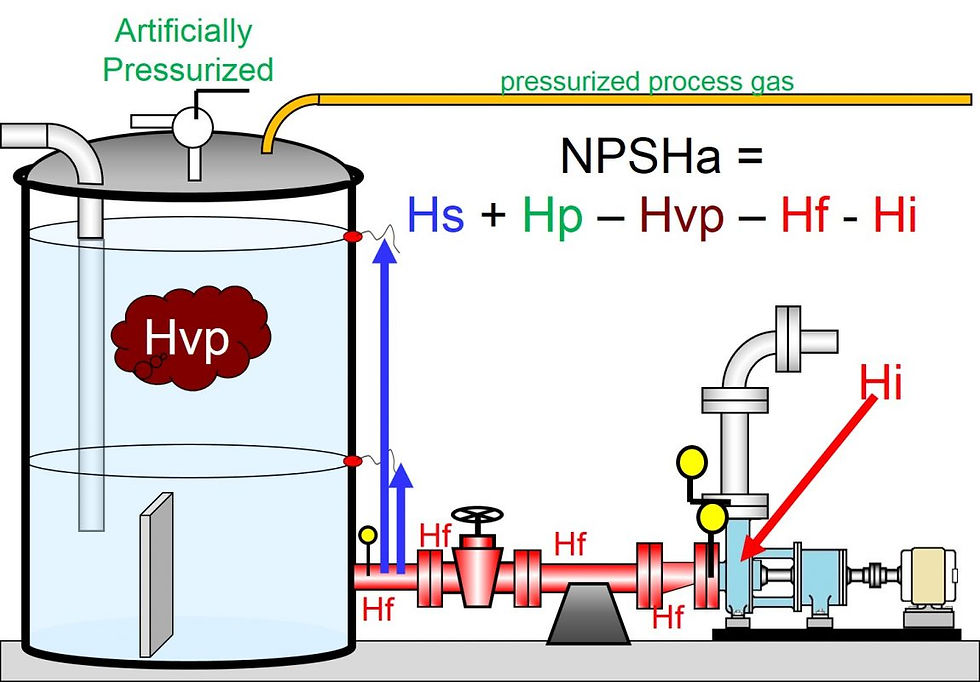NPSH (Net Positive Suction Head) Requirements: Understanding its Importance in Pump Selection
- ADMIN

- Apr 9, 2023
- 2 min read
Introduction: Selecting the right pump for a specific application is crucial for efficient and reliable operations. One of the critical factors to consider during the pump selection process is NPSH or Net Positive Suction Head. NPSH is a measure of the available suction head required by a pump to avoid cavitation.
Understanding NPSH requirements and its impact on pump performance is essential to ensure proper pump selection, operation, and maintenance.

What is NPSH?
NPSH is the measure of the total suction head available at the pump inlet, expressed in meters (feet) of liquid. It represents the difference between the pressure at the pump inlet and the saturation pressure of the liquid at the operating temperature. NPSH is critical to prevent cavitation, which occurs when the pressure at the pump inlet falls below the liquid's vapor pressure. Cavitation can cause significant damage to the impeller and reduce pump performance, leading to increased maintenance costs and downtime.
Factors affecting NPSH requirements:
Several factors can affect the NPSH requirements of a pump, including the impeller design, fluid properties, and system components.
Impeller design: The impeller design plays a crucial role in the NPSH requirement of a pump. Pumps with high-speed impellers require more NPSH than pumps with low-speed impellers. Additionally, impellers with smaller eye diameters require more NPSH than impellers with larger eye diameters.
Fluid properties: The fluid properties, such as density, viscosity, and temperature, can affect the NPSH requirements of a pump. Higher fluid densities and viscosities require more NPSH to prevent cavitation. Additionally, high-temperature liquids have lower vapor pressures, requiring less NPSH than low-temperature liquids.

System components:
System components such as valves, fittings, and pipelines can affect the NPSH requirements of a pump. Components with high pressure drops, such as valves and elbows, can reduce the available suction head and increase the NPSH requirements of a pump.
Impact of NPSH on pump performance:
The NPSH requirement of a pump can significantly affect its performance. If the available NPSH is lower than the required NPSH, cavitation occurs, leading to decreased pump efficiency and reduced flow rates. Additionally, cavitation can cause damage to the impeller, reducing its lifespan and increasing maintenance costs.
Proper pump selection based on NPSH:
Selecting the right pump based on the NPSH requirement is crucial to prevent cavitation and ensure efficient and reliable operations. The NPSH requirement should be determined based on the fluid properties, system components, and operating conditions. The pump manufacturer provides NPSH requirement data, which should be verified before finalizing the pump selection. Additionally, the system should be designed to minimize pressure drops and provide the required suction head to the pump.

Maintaining NPSH requirements:
Maintaining the NPSH requirement of a pump is essential to ensure optimal performance and prevent cavitation. Regular maintenance of system components such as valves and fittings can reduce pressure drops and increase the available suction head. Additionally, monitoring the fluid properties and operating conditions can help maintain the NPSH requirement of the pump. Any changes in the fluid properties or system components should be evaluated to ensure that the NPSH requirement is still met.
Conclusion: NPSH requirements play a crucial role in the selection, operation, and maintenance of pumps. Proper pump selection based on the NPSH requirement can prevent cavitation and ensure efficient and reliable operations.



Comments